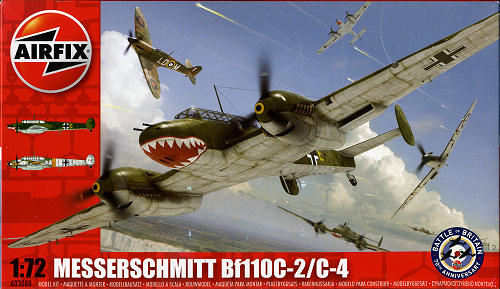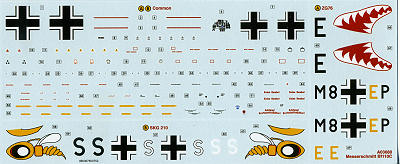
Airfix 1/72 Bf-110C-2/C-4
| KIT #: | A03080 |
| PRICE: | $11.75 MSRP |
| DECALS: | Two options |
| REVIEWER: | Scott Van Aken |
| NOTES: | New mold kit |

| HISTORY |
The Messerschmitt Bf 110, often (erroneously) called Me 110, was a twin-engine heavy fighter (Zerstörer - German for "Destroyer") in the service of the Luftwaffe during World War II. Hermann Göring was a proponent of the Bf 110, and nicknamed it his Eisenseiten ("Ironsides"). Development work on an improved type, the Me 210 that was to replace the Bf 110, begun before the war started, but due to teething troubles, resulted in Bf 110 soldiering on until the end of the war in various roles, alongside its replacements, the Me 210 and the Me 410.
The Bf 110 served with success in the early campaigns, the Polish, Norwegian and Battle of France. The Bf 110's lack of agility in the air was its primary weakness. This flaw was exposed during the Battle of Britain, when some Bf 110 equipped units were withdrawn from the battle after very heavy losses and redeployed as night fighters, a role to which the aircraft was well suited. The Bf 110 enjoyed a successful period following the Battle of Britain as an air superiority fighter and strike aircraft in other theatres. During the Balkans Campaign, North African Campaign and the Eastern Front it rendered valuable ground support to the German Army as a potent fighter-bomber (Jagdbomber-Jabo).
The first really combat ready versions were the 110C variants. These were powered by the Daimler Benz DB 601A, giving quite a boost in power and performance over the preview Jumo engined aircraft. The 110C was to be the last version developed as it was anticipated that the Me-210 would be quickly replacing it. Actuality came into play once again as the 210 was a dismal failure and the 110 stayed in production until near the end of the war.
| THE KIT |
 I
have always wondered why no one has really decided to take the plunge and do a
series of modern mold 1/72 110s. I'd have thought that Hasegawa would have
jumped on this one (and perhaps they still will), but it was Airfix under their
new management who have decided to revisit some old favorites and bring them up
to snuff.
I
have always wondered why no one has really decided to take the plunge and do a
series of modern mold 1/72 110s. I'd have thought that Hasegawa would have
jumped on this one (and perhaps they still will), but it was Airfix under their
new management who have decided to revisit some old favorites and bring them up
to snuff.
If you have seen any of Airfix's new mold kits in the last year or so, then you know that they are modern, engraved detail kits. The engraving itself, while well done, is, in my opinion, a bit overdone for 1/72 scale. However, this has not stopped me from buying and building their kits. The kits offer good detail for most and those who want more will be able to throw money at the aftermarket folks to meet their fix. The kit's cockpit is well appointed with seats, stick, cameras, instrument panels and the like. The main panel has a decal to fit over the flat panel face. No belts are provided for the seats, but Airfix does include a pair of crew members to help fill the seats.
The fuselage has separate nose and tail sections. While not part of this boxing, the longer tail of the 110D is on the sprues for those so inclined. There are separate wheel wells with nicely done detailing and the engine cowlings look about right. Exhaust are on long interlocking tabs. They appear to be able to be installed after the cowlings are glue on, though the instructions would have you attach them prior. The main landing gear have the proper angle on the axles to fit the one-piece, bulged and flattened main wheels. The kit includes a one-piece canopy that to my eyes is a bit on the thick side.
For things to hang from the underside there are several options. One are the rather large, finned long range fuel tanks. The smaller standard tanks are also available. For the centerline is a bomb carrier that can fit either two large or two smaller bombs.
 Instructions
are well drawn with 29 separate construction steps. As is the norm, the only
color information is provided by Humbrol paint numbers with no conversion chart
to what these numbers actually represent. Gone are the full color painting and
markings guide. Two options
Instructions
are well drawn with 29 separate construction steps. As is the norm, the only
color information is provided by Humbrol paint numbers with no conversion chart
to what these numbers actually represent. Gone are the full color painting and
markings guide. Two options are provided. One is the box art plane from I./ZG 76 in France during 1940. The
other is a II./SKG 210 aircraft in partial winter wash in Russia during 1941
with the wasp nose markings. The latter is in RLM 70/71/65 (listed by Airfix as Black
Green/US Light Green/Aircraft Blue). It has a yellow fuselage band and
lower wing tips. The former is apparently in 71/02/65 (though it sure doesn't
look like RLM 02 from the profile to the right). The decals provide markings for both and appear to be well
printed though the swastika is missing from the sheet. The yellow seems to be
opaque enough not to disappear when those markings are applied. A full stencil
placement guide is also provided.
are provided. One is the box art plane from I./ZG 76 in France during 1940. The
other is a II./SKG 210 aircraft in partial winter wash in Russia during 1941
with the wasp nose markings. The latter is in RLM 70/71/65 (listed by Airfix as Black
Green/US Light Green/Aircraft Blue). It has a yellow fuselage band and
lower wing tips. The former is apparently in 71/02/65 (though it sure doesn't
look like RLM 02 from the profile to the right). The decals provide markings for both and appear to be well
printed though the swastika is missing from the sheet. The yellow seems to be
opaque enough not to disappear when those markings are applied. A full stencil
placement guide is also provided.
| CONCLUSIONS |
I think this kit will appeal to all but the really fussy. It appears to be quite accurate in outline and for the price, is a real value for the money.
| REFERENCES |
If you would like your product reviewed fairly and quickly, please contact me or see other details in the Note to Contributors.